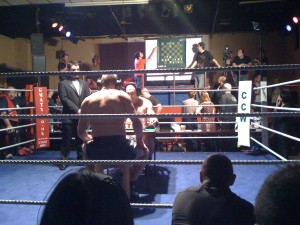Via Tyler Cowen, I am reminded (again) that I should really be reading Steve Waldman more often. Like, all the time. After reading John Hempton’s piece that I highlighted last time, Waldman writes, as an afterthought:
There’s another way to generate price transparency and liquidity for all the alphabet soup assets buried on bank balance sheets that would require no government lending or taxpayer risk-taking at all. Take all the ABS and CDOs and whatchamahaveyous, divvy all tranches into $100 par value claims, put all extant information about the securities on a website, give ’em a ticker symbol, and put ’em on an exchange. I know it’s out of fashion in a world ruined by hedge funds and 401-Ks and the unbearable orthodoxy of index investing. But I have a great deal of respect for that much maligned and nearly extinct species, the individual investor actively managing her own account. Individual investors screw up, but they are never too big to fail. When things go wrong, they take their lumps and move along. And despite everything the professionals tell you, a lot of smart and interested amateurs could build portfolios that match or beat the managers upon whose conflicted hands they have been persuaded to rely. Nothing generates a market price like a sea of independent minds making thousands of small trades, back and forth and back and forth.
I don’t really expect anybody to believe me, but I’ve been thinking something similar.
CDOs, CDOs-squared and all the rest are derrivatives that are traded over the counter; that is, they are traded entirely privately. If bank B sells some to hedge fund Y, nobody else finds out any details of the trade or even that the trade took place. The closest we come is that when bank B announces their quarterly accounts, we might realise that they off-loaded some assets.
On the more popularly known stock and bond markets, buyers publicly post their “bid” prices and sellers post their “ask” prices. When the prices meet, a trade occurs.[*1] Most details of the trade are then made public – the price(s), the volume, the particular details of the asset (ordinary shares in XXX, 2-year senior notes from XXX with an expiry of xx/xx/xxxx, etc) – everything except the identity of the buyer and seller. Those details then provide some information to everybody watching on how the buyer and seller value the asset. Other market players can then combine that with their own private valuations and update their own bid or ask prices accordingly. In short, the market aggregates information. [*2]
When assets are traded over the counter (OTC), each participant can only operate on their private valuation. There is no way for the market to aggregate information in that situation. Individual banks might still partially aggregate information by making a lot of trades with a lot of other institutions, since each time they trade they discover a bound on the valuation of the other party (an upper bound when you’re buying and the other party is selling, a lower bound when you’re selling and they’re buying).
To me, this is a huge failure of regulation. A market where information is not publicly and freely available is an inefficient market, and worse, one that expressly creates an incentive for market participants to confuse, conflate, bamboozle and then exploit the ignorant. Information is a true public good.
On that basis, here is my idea:
Introduce new regulation that every financial institution that wants to get support from the government must anonymously publish all details of every trade that they’re party to. The asset type, the quantity, the price, any time options on the deal, everything except the identity of the parties involved. Furthermore, the regulation would be retroactive for X months (say, two years, so that we get data that predates the crisis). On top of that, the regulation would require that every future trade from everyone (whether they were receiving government assistance or not) would be subject to the same requirementes. Then everything acts pretty much like the stock and bond markets.
The latest edition of The Economist has an article effectively questioning whether this is such a good idea.
[T]ransparency and liquidity are close relatives. One enemy of liquidity is “asymmetric information”. To illustrate this, look at a variation of the “Market for Lemons” identified by George Akerlof, a Nobel-prize-winning economist, in 1970. Suppose that a wine connoisseur and Joe Sixpack are haggling over the price of the 1998 Château Pétrus, which Joe recently inherited from his rich uncle. If Joe and the connoisseur only know that it is a red wine, they may strike a deal. They are equally uninformed. If vintage, region and grape are disclosed, Joe, fearing he will be taken for a ride, may refuse to sell. In financial markets, similarly, there are sophisticated and unsophisticated investors, and unless they have symmetrical information, liquidity can dry up. Unfortunately transparency may reduce liquidity. Symmetry, not the amount of information, matters.
I’m completely okay with this. Symmetric access to information and symmetric understanding of that information is the ideal. From the first paragraph and then the last paragraph :
… Not long ago the cheerleaders of opacity were the loudest. Without privacy, they argued, financial entrepreneurs would be unable to capture the full value of their trading strategies and other ingenious intellectual property. Forcing them to disclose information would impair their incentive to uncover and correct market inefficiencies, to the detriment of all …
Still, for all its difficulties, transparency is usually better than the alternative. The opaque innovations of the recent past, rather than eliminating market inefficiencies, unintentionally created systemic risks. The important point is that financial markets are not created equal: they may require different levels of disclosure. Liquidity in the stockmarket, for example, thrives on differences of opinion about the value of a firm; information fuels the debate. The money markets rely more on trust than transparency because transactions are so quick that there is little time to assess information. The problem with hedge funds is that a lack of information hinders outsiders’ ability to measure their contribution to systemic risk. A possible solution would be to impose delayed disclosure, which would allow the funds to profit from their strategies, provide data for experts to sift through, and allay fears about the legality of their activities. Transparency, like sunlight, needs to be looked at carefully.
This strikes me as being around the wrong way. Money markets don’t rely on trust because their transactions are so fast; their transactions are so fast because they’re built on trust. The scale of the crisis can be blamed, in no small measure, because of the breakdown in that trust.
I also do not buy the idea of opacity begetting market efficiency. It makes no sense. The only way that information disclosure can remove the incentive to “uncover and correct” inefficiencies in the market is if by making the information public you reduce the inefficiency. I’m not suggesting that we force market participants to reveal what they discover before they get the chance to act on it. I’m only suggesting that the details of their action should be public.
[*1] Okay, it’s not exactly like that, but it’s close enough.
[*2] Note that information aggregation does not necessarily imply that the Efficient Market Hypothesis (EMH), but the EMH requires information aggregation to work.
Other posts in this series: 1, 2, 3, 4, 5, [6].

